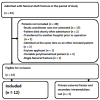Intramedullary nailing of femoral shaft fractures in polytraumatized patients. a longitudinal, prospective and observational study of the procedure-related impact on cardiopulmonary- and inflammatory responses
- PMID: 22221511
- PMCID: PMC3285514
- DOI: 10.1186/1757-7241-20-2
Intramedullary nailing of femoral shaft fractures in polytraumatized patients. a longitudinal, prospective and observational study of the procedure-related impact on cardiopulmonary- and inflammatory responses
Abstract
Background: Early intramedullary nailing (IMN) of long bone fractures in severely injured patients has been evaluated as beneficial, but has also been associated with increased inflammation, multi organ failure (MOF) and morbidity. This study was initiated to evaluate the impact of primary femoral IMN on coagulation-, fibrinolysis-, inflammatory- and cardiopulmonary responses in polytraumatized patients.
Methods: Twelve adult polytraumatized patients with femoral shaft fractures were included. Serial blood samples were collected to evaluate coagulation-, fibrinolytic-, and cytokine activation in arterial blood. A flow-directed pulmonary artery (PA) catheter was inserted prior to IMN. Cardiopulmonary function parameters were recorded peri- and postoperatively. The clinical course of the patients and complications were monitored and recorded daily.
Results: Mean Injury Severity Score (ISS) was 31 ± 2.6. No procedure-related effect of the primary IMN on coagulation- and fibrinolysis activation was evident. Tumor necrosis factor alpha (TNF-α) increased significantly from 6 hours post procedure to peak levels on the third postoperative day. Interleukin-6 (IL-6) increased from the first to the third postoperative day. Interleukin-10 (IL-10) peaked on the first postoperative day. A procedure-related transient hemodynamic response was observed on indexed pulmonary vascular resistance (PVRI) two hours post procedure. 11/12 patients developed systemic inflammatory response syndrome (SIRS), 7/12 pneumonia, 3/12 acute lung injury (ALI), 3/12 adult respiratory distress syndrome (ARDS), 3/12 sepsis, 0/12 wound infection.
Conclusion: In the polytraumatized patients with femoral shaft fractures operated with primary IMN we observed a substantial response related to the initial trauma. We could not demonstrate any major additional IMN-related impact on the inflammatory responses or on the cardiopulmonary function parameters. These results have to be interpreted carefully due to the relatively few patients included.
Trial registration: ClinicalTrials.gov: NCT00981877.
Figures





Similar articles
-
Alterations in the systemic inflammatory response after early total care and damage control procedures for femoral shaft fracture in severely injured patients.J Trauma. 2005 Mar;58(3):446-52; discussion 452-4. doi: 10.1097/01.ta.0000153942.28015.77. J Trauma. 2005. PMID: 15761335
-
Resuscitation before stabilization of femoral fractures limits acute respiratory distress syndrome in patients with multiple traumatic injuries despite low use of damage control orthopedics.J Trauma. 2009 Nov;67(5):1013-21. doi: 10.1097/TA.0b013e3181b890be. J Trauma. 2009. PMID: 19901662
-
Changes in the management of femoral shaft fractures in polytrauma patients: from early total care to damage control orthopedic surgery.J Trauma. 2002 Sep;53(3):452-61; discussion 461-2. doi: 10.1097/00005373-200209000-00010. J Trauma. 2002. PMID: 12352480
-
Early intramedullary nailing of femoral shaft fracture on outcomes in patients with severe chest injury: A meta-analysis.Sci Rep. 2016 Jul 26;6:30566. doi: 10.1038/srep30566. Sci Rep. 2016. PMID: 27457468 Free PMC article. Review.
-
Are bilateral tibial shaft fractures associated with an increased risk for adverse outcome?Injury. 2014 Dec;45(12):1985-9. doi: 10.1016/j.injury.2014.10.005. Injury. 2014. PMID: 25458064 Review.
Cited by
-
Developments in the understanding of staging a "major fracture" in polytrauma: results from an initiative by the polytrauma section of ESTES.Eur J Trauma Emerg Surg. 2024 Jun;50(3):657-669. doi: 10.1007/s00068-023-02245-5. Epub 2023 Feb 23. Eur J Trauma Emerg Surg. 2024. PMID: 36820896 Free PMC article.
-
Prevalence, predictors and outcome of hypofibrinogenaemia in trauma: a multicentre observational study.Crit Care. 2014 Mar 26;18(2):R52. doi: 10.1186/cc13798. Crit Care. 2014. PMID: 24666991 Free PMC article.
-
Do parameters used to clear noncritically injured polytrauma patients for extremity surgery predict complications?Clin Orthop Relat Res. 2013 Sep;471(9):2878-84. doi: 10.1007/s11999-013-2924-8. Clin Orthop Relat Res. 2013. PMID: 23512748 Free PMC article.
-
Complement Activation and Organ Damage After Trauma-Differential Immune Response Based on Surgical Treatment Strategy.Front Immunol. 2020 Jan 31;11:64. doi: 10.3389/fimmu.2020.00064. eCollection 2020. Front Immunol. 2020. PMID: 32117238 Free PMC article.
-
Using IL-6 concentrations in the first 24 h following trauma to predict immunological complications and mortality in trauma patients: a meta-analysis.Eur J Trauma Emerg Surg. 2018 Oct;44(5):679-687. doi: 10.1007/s00068-017-0880-9. Epub 2017 Nov 14. Eur J Trauma Emerg Surg. 2018. PMID: 29138874 Review.
References
-
- O'Toole RV, O'Brien M, Scalea TM, Habashi N, Pollak AN, Turen CH. Resuscitation Before Stabilization of Femoral Fractures Limits Acute Respiratory Distress Syndrome in Patients With Multiple Traumatic Injuries Despite Low Use of Damage Control Orthopedics. J Trauma. 2009;67:1013–1021. doi: 10.1097/TA.0b013e3181b890be. - DOI - PubMed
-
- Pape HC, Rixen D, Morley J, Husebye EE, Mueller M, Dumont C, Gruner A, Oestern HJ, Bayeff-Filoff M, Garving C. et al.Impact of the method of initial stabilization for femoral shaft fractures in patients with multiple injuries at risk for complications (borderline patients) Ann Surg. 2007;246:491–499; discussion 499-501. doi: 10.1097/SLA.0b013e3181485750. - DOI - PMC - PubMed
-
- Pape HC, Tornetta P, Tarkin I, Tzioupis C, Sabeson V, Olson SA. Timing of fracture fixation in multitrauma patients: the role of early total care and damage control surgery. J Am Acad Orthop Surg. 2009;17:541–549. - PubMed
MeSH terms
Substances
Associated data
LinkOut - more resources
Full Text Sources
Medical

